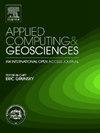Relationships between fault friction, slip time, and physical parameters explored by experiment-based friction model: A machine learning approach using recurrent neural networks (RNNs)
IF 3.2
Q2 COMPUTER SCIENCE, INTERDISCIPLINARY APPLICATIONS
引用次数: 0
Abstract
Understanding the relationship between fault friction and physical parameters is crucial for comprehending earthquake physics. Despite various friction models developed to explain this relationship, representing the relationships in a friction model with greater detail remains a challenge due to intricate correlations, including the nonlinear interplay between physical parameters and friction. Here we develop new models to define the relationship between various physical parameters (slip velocity, axial displacement, temperature, rate of temperature, and rate of axial displacement), friction coefficient, and slip time. The models are established by utilizing Recurrent Neural Networks (RNNs) to analyze continuous data in high-velocity rotary shear experiments (HVR), as reported by previous work. The experiment has been conducted on diorite specimens at a slip velocity (0.004 m/s) in various normal stress (0.3–5.8 MPa). At this conditions, frictional heating occurs inevitably at the sliding surface, reaching temperature up to 68 °C. We first identified the optimal model by assessing its accuracy in relation to the time interval for defining friction. Following this, we explored the relationship between friction and physical parameters with varying slip time and conditions by analyzing the gradient importance of physical parameters within the identified model. Our results demonstrate that the importance of physical parameters continuously shifts over slip time and conditions, and temperature stands out as the most influential parameter affecting fault friction under slip conditions of this study accompanied by frictional heating. Our study demonstrates the potential of deep learning analysis in enhancing our understanding of complex frictional processes, contributing to the development of more refined friction models and improving predictive models for earthquake physics.
基于实验的摩擦模型探讨断层摩擦、滑动时间和物理参数之间的关系:一种使用循环神经网络(rnn)的机器学习方法
了解断层摩擦与物理参数之间的关系对于理解地震物理是至关重要的。尽管开发了各种摩擦模型来解释这种关系,但由于复杂的相关性,包括物理参数和摩擦之间的非线性相互作用,更详细地表示摩擦模型中的关系仍然是一个挑战。在这里,我们开发了新的模型来定义各种物理参数(滑移速度、轴向位移、温度、温度速率和轴向位移速率)、摩擦系数和滑移时间之间的关系。该模型是利用递归神经网络(RNNs)对高速旋转剪切实验(HVR)中的连续数据进行分析而建立的。对闪长岩试样在不同的法向应力(0.3 ~ 5.8 MPa)下,以滑移速度(0.004 m/s)进行了试验。在这种情况下,在滑动表面不可避免地发生摩擦加热,温度可达68℃。我们首先通过评估其与定义摩擦的时间间隔的准确性来确定最佳模型。在此基础上,通过分析所识别模型中物理参数的梯度重要性,探讨了滑移时间和滑移条件不同时摩擦与物理参数之间的关系。我们的研究结果表明,物理参数的重要性随着滑动时间和条件的变化而不断变化,在本研究的滑移条件下,温度是影响断层摩擦的最重要参数,同时伴有摩擦加热。我们的研究证明了深度学习分析在增强我们对复杂摩擦过程的理解方面的潜力,有助于开发更精细的摩擦模型和改进地震物理预测模型。
本文章由计算机程序翻译,如有差异,请以英文原文为准。
求助全文
约1分钟内获得全文
求助全文
来源期刊

Applied Computing and Geosciences
Computer Science-General Computer Science
CiteScore
5.50
自引率
0.00%
发文量
23
审稿时长
5 weeks
 求助内容:
求助内容: 应助结果提醒方式:
应助结果提醒方式:


